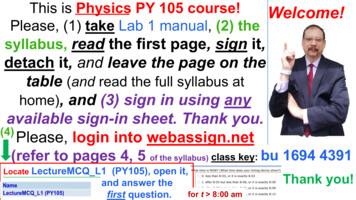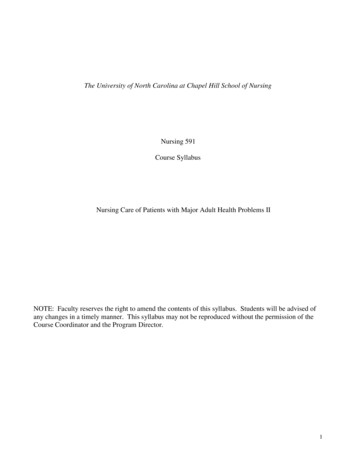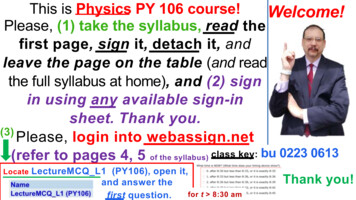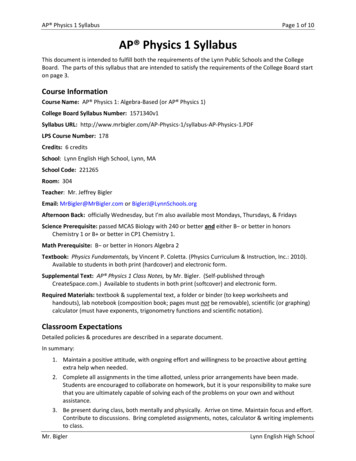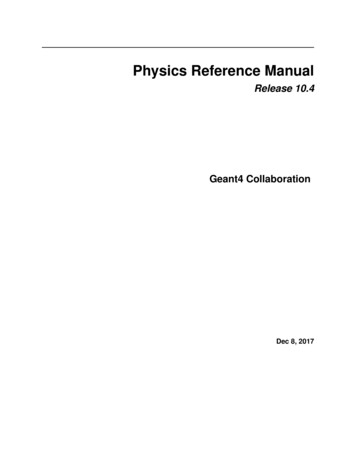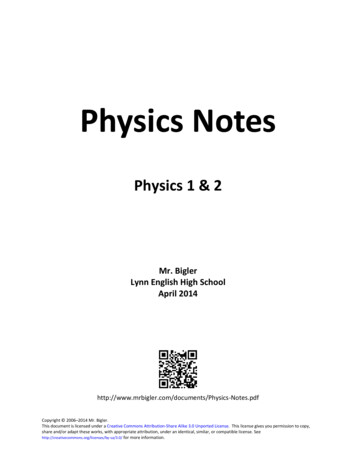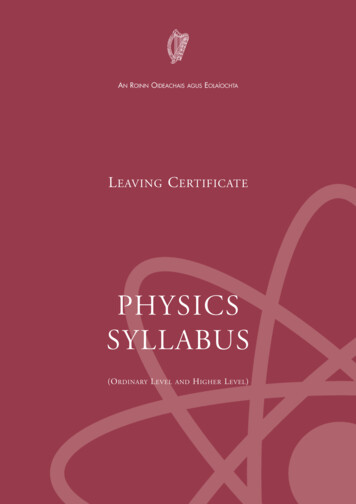
Transcription
AN ROINN OIDEACHAISAGUSEOLAÍOCHTAL EAVING C ERTIFICATEPHYSICSSYLLABUS(O RDINARY L EVELANDH IGHER L EVEL )
LEAVING CERTIFICATE PROGRAMMESAims and Principles1. The general aim of education is to contributetowards the development of all aspects of theindividual, including aesthetic, creative, critical,cultural, emotional, expressive, intellectual, forpersonal and home life, for working life, for living in the community and for leisure.2. Leaving Certificate programmes are presentedwithin this general aim, with a particular emphasis on the preparation of students for therequirements of further education or training, foremployment and for their role as participative,enterprising citizens.3. All Leaving Certificate programmes aim to provide continuity with and progression from theJunior Certificate programme. The relativeweighting given to the various components —e.g. personal and social (including moral andspiritual) development, vocational studies andpreparation for further education and for adultand working life — within the programmes mayvary.4. Programmes leading to the award of the LeavingCertificate are of two years duration and areoffered in three forms:i. The Leaving Certificate (Established)ii. The Leaving Certificate Vocational Programmeiii. The Leaving Certificate Applied5. All Leaving Certificate programmes, in contributing to a high quality education, emphasise theimportance of : self-directed learning and independentthought a spirit of inquiry, critical thinking, problemsolving, self-reliance, initiative and enterprise preparation for further education, for adultand working life lifelong learning.The Leaving Certificate (Established)The Leaving Certificate (Established) programmeoffers students a broad and balanced educationwhile allowing for some specialisation.Syllabuses are provided in a wide range of subjects. All subjects are offered at Ordinary andHigher levels. In addition, Mathematics and Irishare also offered at Foundation level.The certificate is used for purposes of selectioninto further education, employment, training andhigher education.The Leaving Certificate VocationalProgramme (LCVP)The Leaving Certificate Vocational Programme isan intervention within the Leaving Certificate(Established). LCVP students study a minimumof five subjects (at Higher, Ordinary orFoundation levels), including Irish and two subjects from specified vocational subject groupings.They are also required to take a recognisedcourse in a Modern European language, otherthan Irish or English. In addition LCVP studentstake three Link Modules on Enterprise Education,Preparation for Work and Work Experience.In particular, the LCVP aims to foster in studentsa spirit of enterprise and initiative and to develop their interpersonal, vocational and technological skills.The Leaving Certificate AppliedThe Leaving Certificate Applied is a distinct, selfcontained Leaving Certificate programme. It isdesigned for those students who do not wish toproceed directly to third level education or forthose whose needs, aspirations and aptitudesare not adequately catered for by the other twoLeaving Certificate programmes. The LeavingCertificate Applied is structured around threemain elements – Vocational Preparation,Vocational Education and General Education which are interrelated and interdependent. Thisprogramme is characterised by educational experiences of an active, practical and student-centred nature.
LEAVING CERTIFICATEPHYSICS(ORDINARY AND HIGHER LEVEL)
L E A V I N G C E R T I F I C AT E P H Y S I C S S Y L L A B U S PreamblePolicy ContextScience education in the senior cycle should reflectthe changing needs of students and the growingsignificance of science for strategic development inIreland.Leaving Certificate science syllabuses are designed toincorporate the following components: science for the enquiring mind, or pure science, toinclude the principles, procedures and concepts ofthe subject as well as its cultural and historicalaspects science for action, or the applications of scienceand its interface with technology science, which is concerned with issues – political,social and economic – of concern to citizens.The three components should be integrated withineach science syllabus, with the first componenthaving a 70% weighting. The remaining 30% shouldbe allocated to the other two components in the ratio3 to 1.The syllabuses, which are offered at two levels,Higher and Ordinary, will have approximately 180hours of class contact time over a two-year period.They should be practically and experimentally basedin their teaching.
L E A V I N G C E R T I F I C AT E P H Y S I C S S Y L L A B U S CONTENTSIntroduction . . . . . . . . . . . . . . . . . . . . . . . 2Ordinary Level Syllabus . . . . . . . . . . . 5Higher Level Syllabus . . . . . . . . . . . . 23Ordinary Level Objectives . . . . . . . . . . . . . . . . . .6Ordinary Level Objectives . . . . . . . . . . . . . . . . .24Mechanics . . . . . . . . . . . . . . . . . . . . . . . . . . . . . .7Mechanics . . . . . . . . . . . . . . . . . . . . . . . . . . . . .25Temperature . . . . . . . . . . . . . . . . . . . . . . . . . . . .10Temperature . . . . . . . . . . . . . . . . . . . . . . . . . . . .28Heat . . . . . . . . . . . . . . . . . . . . . . . . . . . . . . . . .11Heat . . . . . . . . . . . . . . . . . . . . . . . . . . . . . . . . .29Waves . . . . . . . . . . . . . . . . . . . . . . . . . . . . . . . .12Waves . . . . . . . . . . . . . . . . . . . . . . . . . . . . . . . .30Vibrations and Sound . . . . . . . . . . . . . . . . . . . . .13Vibrations and Sound . . . . . . . . . . . . . . . . . . . . .31Light . . . . . . . . . . . . . . . . . . . . . . . . . . . . . . . . .14Light . . . . . . . . . . . . . . . . . . . . . . . . . . . . . . . . .32Electricity . . . . . . . . . . . . . . . . . . . . . . . . . . . . .16Electricity . . . . . . . . . . . . . . . . . . . . . . . . . . . . .34Modern Physics . . . . . . . . . . . . . . . . . . . . . . . . .20Modern Physics . . . . . . . . . . . . . . . . . . . . . . . . .39Option 1: Particle Physics . . . . . . . . . . . . . . . . . .42Option 2: Applied Electricity . . . . . . . . . . . . . . .44Mathematical Requirements at Ordinary and Higher Level . . . . . . . . . . . . . .45Notations and Symbols at Ordinary and Higher Level . . . . . . . . . . . . . . . . . . . .47Formulas at Ordinary and Higher Level . . . . . . . . . . . . . . . . . . . . . . . . . . . . . . . . . . . . .521
L E A V I N G C E R T I F I C AT E P H Y S I C S S Y L L A B U S IntroductionAimsThe aims of the syllabus, common to both levels,The science, technology and society (STS)component places the content within a relevantcontext. The format in which the syllabus is presenteddoes not imply any particular order of teaching.Teaching strategies should promote, in a positivemanner, the aims and objectives of the syllabus.are: to give students an understanding of thefundamental principles of physics and theirapplication to everyday life and technology to develop an appreciation of physics as a humanendeavour, thereby enriching the students’Activities describe how the syllabus objectives are tobe achieved as the content is studied. The activitiescolumn provides a pedagogical approach to thesyllabus by outlining the relevant demonstrations andby indicating where problem-solving is required.Where resources permit, the use of spreadsheets, datalogging, computer-aided learning, modelling andsimulation is recommended. Slides, posters andvideos are excellent resource materials, and their usein implementing the syllabus is recommended.Additional activities may be included whereappropriate.experience of life to provide a reasonably broad perspective ofphysics, thus developing an understanding of thephysical environment and of how human beingsinteract with it to provide a general education in physics for allstudents, whether or not they proceed to furtherstudies in physics to develop the ability to observe, to thinklogically, and to communicate effectively to develop an understanding of the scientificmethodThe science, technology and society (STS)component places the concepts, principles andtheories of physics within relevant contexts by(a) referring to the applications of physics and(b) solving problems set in the everyday world.It is important to include personal, medical,biological and social examples of physics as well asmechanical or technical examples, so that the place ofphysics in the everyday world can be appreciated.Establishing links with local industry would be ofgreat importance in implementing this aspect of thesyllabus. The links between history, culture,philosophy and physics should also be included.Students, through their study of physics, shoulddevelop a critical awareness of the limitations of, andconstraints on, physics. Therefore, as citizens, theycan contribute constructively to the development oftheir society on social, economic and environmentalissues, some of which may be controversial. to develop an appreciation of physics as acreative activity, using informed intuition andimagination to create an understanding of thebeauty, simplicity and symmetry in nature.Structure of the SyllabusThe entire Ordinary level syllabus is presented firstfollowed by the entire Higher level syllabus. Thesyllabus is presented in four columns: content depth of treatment activities science, technology, and society (STS).The content and the depth of treatment required arestated. The activities given in the syllabus provideopportunities to achieve the objectives of the syllabus.2
L E A V I N G C E R T I F I C AT E P H Y S I C S S Y L L A B U S laboratory. Those required are indicated in theactivities column by the term “demonstration ofeffect”.STS is an integral part of the syllabus at bothOrdinary and Higher levels, so that students canplace physics within the everyday world. The STSmaterial needs to be known at the appropriate level;that is, where the basic principle is on the Ordinarylevel, examples must be known at Ordinary level, andsimilarly at Higher level. Only the principles of theapplications listed in STS are required. Technicaldetails, e.g. structural details, operational details, etc.,are not required. The list of applications is notexhaustive and additional applications may beincluded where appropriate.Experimental error: There should be an appreciation of the errors inherent in an experiment and ofthe precautions that can be taken to reduce sucherrors. No quantitative treatment is required.Differentiation between Higher leveland Ordinary levelThere are three main differences between Higher leveland Ordinary level: structure and contentThe mathematical requirements are stated on pages45 and 46. The notation and symbols to be used aredefined on pages 47 to 51 and the formulas sectionon pages 52 to 54 indicates the equations relevant tothe syllabus. depth of treatment mathematical treatment.Structure and content: Ordinary level consists of adefined set of concepts. Higher level consists of theOrdinary level concepts, additional concepts, andeither Option 1 (Particle Physics) or Option 2(Applied Electricity). The additional concepts atHigher level are printed in black text.Practical workStudents must follow a course of practical work. Theexperiments listed at the end of each section of thesyllabus must be carried out by the students and anadequate record of such work must be retained forthe period of the course.Depth of treatment: Ordinary level provides anoverview of physics and its applications to everydaylife, while at Higher level there is a deeper, morequantitative treatment of physics.Standard laboratory safety precautions must beobserved, and due care must be taken whencarrying out all experiments.Mathematical treatment: Equations must beknown and used at Ordinary level. At Higher levelcertain equations must be derived; the other equations must be known and used. The formulas section(pages 52 to 54) indicates the equations relevant tothe syllabus. Appropriate calculations are essentialthroughout to develop students’ skills and understanding.The hazards associated with electricity, EHT, lasersetc. should be identified where possible, andappropriate precautions taken. The careful use ofsources of ionising radiation is essential. It isimportant that teachers follow guidelines issued bythe Department of Education and Science.It is recommended that the practical work listed inthe syllabus be supplemented by teacherdemonstrations, further student practical work, andstudent investigations, as appropriate. Where possible,physical phenomena should be demonstrated in the3
L E A V I N G C E R T I F I C AT E P H Y S I C S S Y L L A B U SAssessment objectivesThe syllabus will be assessed under the headingsknowledge, understanding, skills, and competence.The attitudinal objectives will be assessed wherefeasible. All material within the syllabus isexaminable.It should be noted that STS is examinable. Studentswill be expected to have a knowledge of generalapplications but will not be required to have adetailed knowledge of specific applications.Practical work is an integral part of the study ofphysics; it will initially be assessed through themedium of the written examination paper. Anelement of practical assessment may be included aspart of the overall assessment at a later stage.4
LEAVING CERTIFICATE PHYSICSORDINARY LEVELSYLL ABUS5
L E A V I N G C E R T I F I C AT E P H Y S I C S O R D I N A R Y L E V E L S Y L L A B U S Ordinary Level Syllabus ObjectivesOrdinary level physics provides an introduction to, and an overview of, physics.Students are expected to develop an appreciation of the fundamental lawsand principles and their application to everyday life.The objectives of the syllabus are:1. Knowledge4. CompetenceStudents should know basic physical principles, terminology, facts, andmethods that physics is fundamental to many technologicaldevelopments that physics contributes to the social, historical,environmental, technological and economic life ofsociety.Students should be able to present information in tabular, graphical, writtenand diagrammatic form, as appropriate report concisely on experimental procedures andresults use calculators solve numerical problems read popular science writing relate scientific concepts to issues in everyday life explain the science underlying familiar facts,observations, and phenomena.2. UnderstandingStudents should understand basic physical principles how physical problems can be solved how the scientific method contributes to physics how physics relates to everyday life.5. AttitudesStudents should appreciate the contribution of physics to the social andeconomic development of society the relationship between physics and technology that a knowledge of physics has many vocationalapplications.3. SkillsStudents should be able to measure physical quantities in the appropriate SIunits work safely in a laboratory follow instructions use scientific equipment appropriately use experimental data appropriately.6
L E A V I N G C E R T I F I C AT E P H Y S I C S O R D I N A R Y L E V E L S Y L L A B U S MECHANICSContentDepth of TreatmentActivitiesSTSMOTION1. Linear motion2. Vectors and ScalarsUnits of mass, length and time –definition of units not required.Displacement, velocity, acceleration: definitions and units.Measurement of velocity andacceleration, using any suitableapparatus. Use of distance-time,velocity-time graphs.Equations of motion.Measurement of g.Appropriate calculations.Distinction between vector andscalar quantities.Sports, e.g. athletics.Vector nature of physicalquantities: everyday examples.FORCES1. Newton’s laws ofmotionStatement of the three laws.Demonstration of the laws usingair track or tickertape timer orpowder track timer, etc.Force and momentum, definitionsand units. Vector nature of forcesto be stressed.F ma as a special case ofNewton’s second law.Friction: a force opposing motion.2. Conservation ofmomentumApplications seat belts rocket travel.Sports, all ball games.Appropriate calculations.Importance of friction ineveryday experience, e.g.walking, use of lubricants, etc.Principle of conservation ofmomentum.Demonstration by any onesuitable method.Appropriate calculations (problemsinvolving change of mass neednot be considered).7Collisions (ball games), acceleration of spacecraft, jet aircraft.
L E A V I N G C E R T I F I C AT E P H Y S I C S O R D I N A R Y L E V E L S Y L L A B U S MECHANICS (CONTINUED)ContentDepth of TreatmentActivitiesSTSNewton’s law of universalgravitation.Gm 1 m 2F d2Weight mgCompare gravitational forcesbetween Earth and Sun andbetween Earth and Moon.Solar system.Value of acceleration due togravity on other bodies in space,e.g. Moon.Calculation of weight on differentplanets.Presence of atmosphere.Definitions and units.Pressure in liquids and gases.Boyle’s law.Archimedes’ principle.Law of flotation.Demonstration of atmosphericpressure, e.g. collapsing-canexperiment. Appropriate calculations.Demonstration only. Calculationsnot required.Atmospheric pressure and weather.The “bends” in diving, etc.5. MomentsDefinition.Levers.Couple.Simple experiments with anumber of weights. Appropriatecalculations. (Only problemsinvolving co-planar parallel forcesneed be considered.)Torque, e.g. taps, doors.Handlebars on bicycles.Reference to moving-coil metersand simple motor.6. Conditions forequilibriumThe sum of the forces in anydirection equals the sum of theforces in the opposite direction.The sum of the moments aboutany point is zero.Appropriate calculations.Static and dynamic equilibrium.3. Gravity4. Density andpressure8Hydrometers.
L E A V I N G C E R T I F I C AT E P H Y S I C S O R D I N A R Y L E V E L S Y L L A B U S MECHANICS (CONTINUED)ContentDepth of TreatmentActivitiesSTSENERGY1. WorkDefinition and unit.Simple experiments. Appropriatecalculations involving force anddisplacement in the samedirection only.Lifts, escalators.2. EnergyEnergy as the ability to do work.Different forms of energy.E P mghEk 12 mv 2Mass as a form of energyE mc 2Conversions from one form ofenergy to another.Principle of conservation ofenergy.Demonstrations of different energyconversions.Appropriate calculations.Sources of energy: renewable andnon-renewable.Power as the rate of doing workor rate of energy conversion.Unit.Estimation of average powerdeveloped by person running upstairs person repeatedly liftingweights, etc.3. PowerMass transformed to other formsof energy in the Sun.Efficient use of energy in thehome.Percentage efficiencyPower output x 100 Power inputAppropriate calculations.MECHANICS: Experiments1.2.3.4.5.6.Measurement of velocity and acceleration.To show that a F.Verification of the principle of conservation of momentum.Measurement of g.Verification of Boyle’s law.Investigation of the laws of equilibrium for a set of co-planar forces.9Power of devices, e.g. lightbulbs, motors, etc.
L E A V I N G C E R T I F I C AT E P H Y S I C S O R D I N A R Y L E V E L S Y L L A B U S TEMPERATUREContentDepth of TreatmentActivities1. Concept oftemperatureMeasure of hotness or coldness ofa body.The SI unit of temperature is thekelvin (definition of unit in termsof the triple point of water notrequired).Celsius scale is the practicaltemperature scalet /ºC T /K – 273.152. ThermometricpropertiesA physical property that changesmeasurably with temperature.Demonstration of somethermometric properties: length of liquid column,e.g. length of mercurycolumn emf of thermocouple resistance pressure of a gas atconstant volume volume of a gas atconstant pressure colour.3. ThermometersThermometers measuretemperature.Two thermometers do notnecessarily give the same readingat the same temperature.The need for standardthermometers – use anycommercial laboratorythermometer as school standard.Graduate two thermometers at iceand steam points. Compare valuesobtained for an unknowntemperature, using a straight-linegraph between reference points.10STSPractical thermometers, e.g. clinical thermometer, oven thermometers, boiler thermometers, temperature gauge in a car.
L E A V I N G C E R T I F I C AT E P H Y S I C S O R D I N A R Y L E V E L S Y L L A B U S HEATContent1. Concept of heatDepth of TreatmentActivitiesSTSHeat as a form of energy thatcauses a rise in temperaturewhen added or a fall intemperature when withdrawn.QUANTITY OF HEAT1. Heat capacity,specific heatcapacityDefinitions and units.Appropriate calculations.Storage heaters.2. Latent heat,specific latent heatDefinitions and units.Appropriate calculations.Heat pump, e.g. refrigerator.Perspiration.Qualitative comparison of rates ofconduction through solids.Simple experiments.U-values: use in domesticsituations.Simple experiments.Domestic hot-water and heatingsystems.Simple experiments.Everyday examples.Solar heating.HEAT TRANSFER1. Conduction2. Convection3. Radiation1.2.3.4.Radiation from the Sun.Solar constant (also called solarirradiance).HEAT: ExperimentsCalibration curve of a thermometer using the laboratory mercury thermometer as a standard.Measurement of specific heat capacity, e.g. of water or a metal by a mechanical or electrical method.Measurement of the specific latent heat of fusion of ice.Measurement of the specific latent heat of vaporisation of water.11
L E A V I N G C E R T I F I C AT E P H Y S I C S O R D I N A R Y L E V E L S Y L L A B U S WAVESContent1. Properties of waves2. Wave phenomenaDepth of TreatmentActivitiesLongitudinal and transverse waves:frequency, amplitude, wavelength,velocity.Relationship c f λSTSAppropriate erference.Polarisation.Simple demonstrations usingslinky, ripple tank, microwaves, orother suitable method.Everyday examples, e.g. radio waves waves at sea seismic waves.Sound from a moving source.Red shift of stars.Speed traps.Stationary waves; relationshipbetween inter-node distance andwavelength.Diffraction effects at an obstacle at a slitwith reference to significance ofthe wavelength.3. Doppler effectQualitative treatment.12
L E A V I N G C E R T I F I C AT E P H Y S I C S O R D I N A R Y L E V E L S Y L L A B U S VIBRATIONS AND SOUNDContent1. Wave nature ofsound2. Characteristics ofnotesDepth of TreatmentActivitiesReflection, refraction, diffraction,interference.Demonstration of interference, e.g.two loudspeakers and a signalgenerator.Speed of sound in various media.Demonstration that sound requiresa medium.Amplitude and loudness, frequencyand pitch, quality and overtones.Frequency limits of audibility.STSAcoustics.Reduction of noise usingdestructive interference. Noisepollution.Dog whistle.3. ResonanceNatural frequency. Fundamentalfrequency.Definition of resonance, andexamples.Demonstration using tuning forksor other suitable method.Vocal cords (folds).4. Vibrations instrings and pipesStationary waves in strings andpipes. Relationship betweenfrequency and length.Use string and wind instruments,e.g. guitar, tin whistle.String section and woodwindsection in orchestras.5. Sound intensitylevelThreshold of hearing andfrequency response of the ear.Sound intensity level, measured indecibels.The dB(A) scale is used becauseit is adapted to the ear’sfrequency response.Use of sound-level meter.Examples of sound intensitylevel.Hearing impairment.Ear protection in industry, etc.SOUND: Experiments1. Measurement of the speed of sound in air.2. Investigation of the variation of fundamental frequency of a stretched string with length.13
L E A V I N G C E R T I F I C AT E P H Y S I C S O R D I N A R Y L E V E L S Y L L A B U S LIGHTContentDepth of TreatmentActivitiesSTSREFLECTIONDemonstration using ray box orlaser or other suitable method.1. Laws of reflection2. MirrorsImages formed by plane andspherical mirrors.Knowledge thatReal-is-positive sign convention.Simple exercises on mirrors byray tracing or use of formula.Practical uses of sphericalmirrorsConcaveConvex dentists supermarkets floodlights driving mirrors projectors1 1 1 andu vvm ufREFRACTION1. Laws of refractionRefractive index.Demonstration using ray box orlaser or other suitable method.Appropriate calculations.Practical examples, e.g. real andapparent depth of fish in water.2. Total internalreflectionCritical angle.Relationship between critical angleand refractive index.Transmission of light throughoptical fibres.Demonstration.Appropriate calculations.Reflective road signs.Mirages.Prism reflectors.Uses of optical fibres: telecommunications medicine (endoscopes).3. LensesImages formed by single thinlenses.Knowledge thatSimple exercises on lenses by raytracing or use of formula.Uses of lenses.1 1 1 andu vvm ufPower of lens: P 1fTwo lenses in contact:P P1 P 2The eye: optical structure;short sight, long sight,and corrections.Spectacles.14
L E A V I N G C E R T I F I C AT E P H Y S I C S O R D I N A R Y L E V E L S Y L L A B U S LIGHT (CONTINUED)ContentDepth of TreatmentActivitiesSTSWAVE NATURE OF LIGHT1. Diffraction andinterferenceUse of diffraction grating formula.nλ d sinθSuitable method of demonstratingthe wave nature of light.Appropriate calculations.Interference colours petrol film, soap bubbles.2. Light as a transverse wave motionPolarisation.Demonstration of polarisationusing polaroids or other suitablemethod.Stress polarisation.Polaroid sunglasses.3. DispersionDispersion by a prism and adiffraction grating.Recombination by a prism.Demonstration.Rainbows, polished gemstones.Colours seen on surfaces ofcompact discs.4. ColoursPrimary, secondary andcomplementary colours.Addition of colours. Pigmentcolours need not be considered.Demonstration.Stage lighting, television.5. Electromagneticspectrum6. The spectrometerRelative positions of radiations interms of wavelength andfrequency.Detection of UV and IR radiation.Demonstration.Demonstration.The spectrometer and thefunction of its parts.LIGHT: Experiments1.2.3.4.5.Measurement of the focal length of a concave mirror.Verification of Snell’s law of refraction.Measurement of the refractive index of a liquid or a solid.Measurement of the focal length of a converging lens.Measurement of the wavelength of monochromatic light.15Ultraviolet and ozone layer.Infrared cameras: medical applications night vision.Greenhouse effect.
L E A V I N G C E R T I F I C AT E P H Y S I C S O R D I N A R Y L E V E L S Y L L A B U S ELECTRICITYContentDepth of TreatmentActivitiesSTSCHARGES1. Electrification bycontactCharging by rubbing togetherdissimilar materials.Types of charge: positive,negative.Conductors and insulators.Unit of charge: coulomb.Demonstration of forces betweencharges.Domestic applications: dust on television screen static on clothes.Industrial hazards in flour mills fuelling aircraft.Demonstration using an insulatedconductor and a nearby chargedobject.2. Electrification byinduction3. Distribution ofcharge onconductorsTotal charge resides on outside ofa metal object.Charges tend to accumulate atpoints.Point discharge.4. ElectroscopeStructure.Van de Graaff generator can beused to demonstrate thesephenomena.Lightning.Lightning conductors.Uses.ELECTRIC FIELD1. Force betweenchargesCoulomb’s law1Q1 Q 24π εd2an example of an inverse squarelaw.F 2. Electric fieldsIdea of lines of force.Vector nature of electric field tobe stressed.Demonstration of field patternsusing oil and semolina or othermethod.3. Potential differenceDefinition of potential difference:work done per unit charge totransfer a charge from one pointto another.Definition of volt.Concept of zero potential.Appropriate calculations.16Precipitators.Xerography.Hazards: effect of electric fieldson integrated circuits.
L E A V I N G C E R T I F I C AT E P H Y S I C S O R D I N A R Y L E V E L S Y L L A B U S ELECTRICITY (CONTINUED)ContentDepth of TreatmentActivitiesSTSCAPACITANCE1. Capacitors andcapacitanceDefinition: C Q/VUnit of capacitance.Appropriate calculations.Parallel plate capacitor.Common uses of capacitors: tuning radios flash guns smoothing filtering.Energy stored in a capacitor.Charge capacitor – dischargethrough lamp or low-voltage d.c.motor.Capacitors – conduct a.c. but notd.c.Demonstration.ELECTRIC CURRENT1. Electric currentDescription of electric current as–flow of charge 1 A 1 C s 12. Sources of emf andelectric currentPd and voltage are the samething; they are measured in volts.A voltage when applied to acircuit is called an emf.3. Conduction inmaterialsConduction in metals ionic solutions(active and inactive electrodes) gases vacuum semiconductors.References in each case to chargecarriers.Sources of emf: mains, simplecells, lead-acid accumulator, carbatteries, dry batteries,thermocouple.Interpretation of I–V graphs.Neon lamps, street lights.Conduction in semiconductors: thedistinction between intrinsic andextrinsic conduction; p-type andn-type semiconductors.Electronic devices.LED, computers, integratedcircuits.The p-n junction: basic principlesunderlying current flow across ap-n junction.Demonstration of current flowacross a p-n junction in forwardand reverse bias, e.g. using a bulb.17Rectification of a.c.
L E A V I N G C E R T I F I C AT E P H Y S I C S O R D I N A R Y L E V E L S Y L L A B U S ELECTRICITY (CONTINUED)ContentDepth of TreatmentActivitiesSTSDefinition of resistance, unit.Ohm's law.Resistance varies with length,cross-sectional area, andtemperature.Resistivity.Resistors in series and parallel.Appropriate calculations.LDR – light-dependent resistor.Thermistor.Demonstration of LDR andthermistor.5. PotentialPotential divider.Demonstration.Potentiometer as a variablepotential divider.6. Effects of electriccurrentHeating: W I 2RtDemonstration of effect.Appropriate calculations.Everyday examples.Advantage of use of EHT intransmission of electrical energy.Chemical: an electric current cancause a chemical reaction.Magnetic effect of
theories of physics within relevant contexts by (a) referring to the applications of physics and (b) solving problems set in the everyday world. It is important to include personal, medical, biological and social examples of physics as well as mechanical or technical examples, so that the place of p


